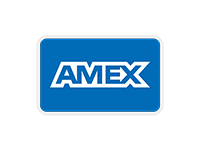By Alex Stroshane and Matt Donnelly With special thanks to Deane Ellsworth and Bill Hakkarinen
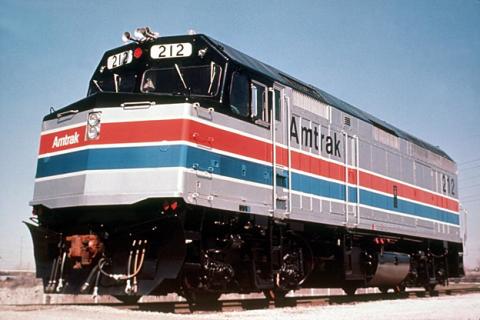
Builder’s photo of Amtrak F40PH no. 212. EMD photo.
Introduction
By the mid-1970s, Amtrak had a need for versatile and reliable power for its trains. Inherited E and F units were nearing the end of their useful lives and needed to be replaced. At the same time, new Amfleet equipment was being delivered for use on short-haul trains, and these cars used Head-End Power (HEP) instead of steam heat. The first two new locomotive types Amtrak purchased, the SDP40F and P30CH, were each found to have their own teething issues, so it was time to go back to the drawing board.
The first 30 F40PH units, delivered by EMD in 1976, were used primarily in New England in the east and Los Angeles on San Diegan corridor trains on the west coast. They were so successful that Amtrak moved quickly to purchase more F40s to cover long-haul routes as well. As a cost-saving measure, and a sign of their faith in the new design, the majority of Amtrak’s SDP40F fleet were traded in to EMD so their prime movers and other components could be re-used. These units emerged with an F40PHR designation, and more than made up for the shortcomings of their six-axle ancestors. With a total of 210 units built for Amtrak, and dozens more for commuter agencies, the F40PH became the face of modern passenger railroading and remained so for over 20 years.
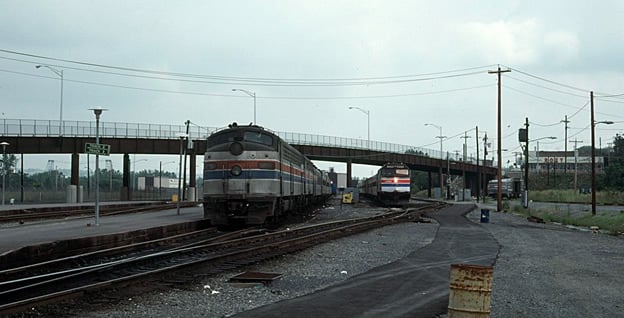
An E8 (left) at Albany-Rensselaer, soon to be replaced by the F40PH (right). July 28, 1979. Photo by Gerrit Bruins, collection of Alex Stroshane.
The F40PH Design
Deane Ellsworth was the Amtrak Manager of Locomotive Development who authored the specifications for what would become the F40PH. Abandoning the traditional approach of heavy six-axle units, he worked closely with EMD’s design team to pack all of the necessary equipment onto a smaller, lighter four-axle frame. Built around EMD’s venerable 16-cylinder 645E3 power plant, the F40PH was rated at 3000 HP, but they featured a unique control system to allow them to provide head-end power.
The F40’s alternator for the HEP was driven directly off the prime mover, and in order to supply power at the correct 480V and 60Hz, it had to run at exactly 896 RPM. With the engine constantly running at full throttle when providing HEP, the engineer’s throttle inputs had no impact on the sound of the prime mover revving up or down. Instead, to control the locomotive’s speed, the throttle varied the electric current supplied to the traction motors. It was quite unique to see an F40PH coast into a station and come to a stop, all while roaring at full bore. This led to the nickname "screamer," as the turbocharged prime mover was always working hard, and it let you know.
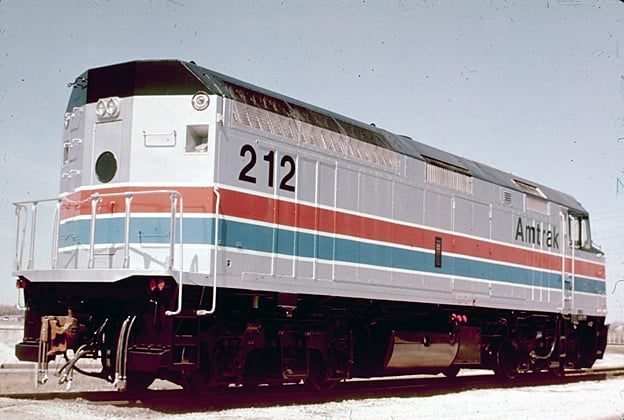
Builder’s photo showing rear of Amtrak 212. EMD photo.
When HEP was not required, the unit would be switched to conventional throttle control, operating much like a freight unit. In fact, some of Amtrak’s F40PHs were occasionally leased by freight railroads when they were short on power. Further still, if a train were laying over in a terminal, the F40 could be put in ‘standby’ HEP mode, allowing the engine to run at a notch 6 RPM equivalent to supply HEP from the main generator while stationary. This saved fuel and reduced noise.
When two F40s were used on a train, it was normal practice to have the trailing unit provide the HEP and run at full RPM, while the lead unit would operate conventionally (resulting in less noise for the engineer).
Mr. Ellsworth recalls: "I am happy with the way the F40PH turned out. As I now think on it, they were different from anything EMD had ever made. They came at a time when no one in the US was building passenger locomotives; no American builder had one in their catalog." It’s clear that there was a need, and the F40PH filled that need proudly.
F40PH Phases: Spotting Differences
By now, we hope you’ve increased your F40PH knowledge exponentially. To make sure you’re still with us, let’s look at some photos. Since the Rapido model represents a Phase 1 unit, we’ll go over all of the phases so that you can tell those intimate details of the Phase 1 from the rest.
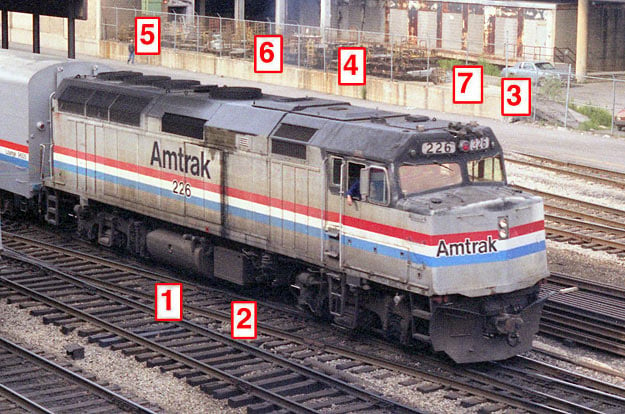
Phase 1 #226 outside Chicago Union Station in June 1985. Photo by Bill Hakkarinen.
Amtrak’s first F40PH order (200-229) is known in the railfan community as the Phase 1 version. They were built with 1500-gallon fuel tanks mounted toward the rear of the frame (1), with air reservoirs and battery boxes to the front (2). Internally, a 500 kW alternator supplied the HEP. The Phase 1 units were also the only F40PHs to be specified with Nathan P1234a5 (P5A) horns. The horns were slightly recessed to meet clearance envelopes in the Northeast, resulting in an appropriately-sized notch in the cab roof (3). For this same reason, a low-profile exhaust silencer (4) and radiator fans (5) were fitted, although the dynamic brake fan (6) is a standard-height EMD part. Twin xenon strobe lights (7) were also mounted on the cab roof.
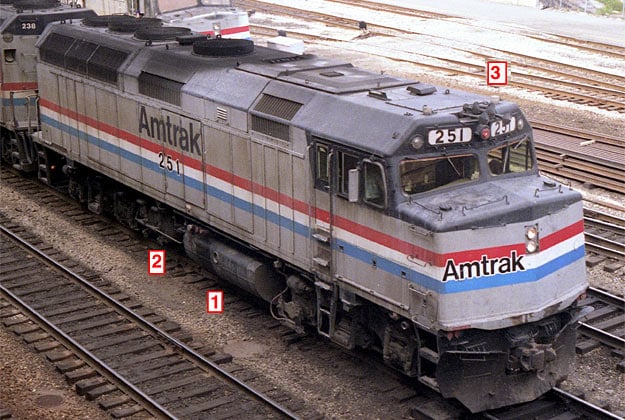
A view at the 251, a Phase 2a F40, outside Chicago Union Station in June 1985. Photo by Bill Hakkarinen.
Beginning with Amtrak’s second F40PH order, several changes were made to the design. Phase 2a and 2b units (230-279, 280-328) received larger 1800-gallon fuel tanks (1) mounted toward the front of the frame. The air reservoirs (2) were shifted toward the rear and to the engineer’s side, while the battery boxes were located on the fireman’s side. The HEP alternator was upgraded to 800 kW to better handle long-distance trains. Newer and wider Nathan K5LA horns were specified, requiring a wider horn notch (3). Ironically, the F40 pictured above has had its K5LA swapped for a P5A, though the reverse swap could not be made to a Phase 1 unit. It is interesting to note that both the P5A and K5LA horns were developed for Amtrak at Mr. Ellsworth’s direction to give its locomotives a distinct train sound.
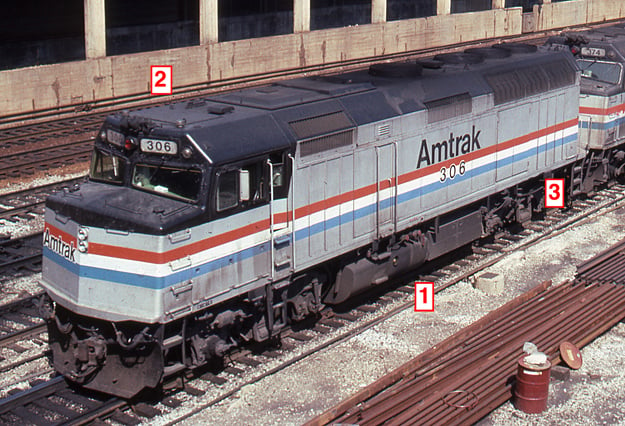
Phase 2b (306) F40 departs Chicago Union Station on August 17, 1988. Collection of Matt Donnelly.
In this view, we can see the battery boxes on the fireman’s side (1) and the typical K5LA horn (2). There is also a minor distinction to be made within the Phase 2 group. Pay close attention to the number of vertical ribs at the rear on each side of the carbody (3). Phase 1 and 2a units have three, while Phase 2b and later units have four. This change first appeared on no. 280, but has been incorrectly cited in other articles as applying to all Phase 2 F40s.
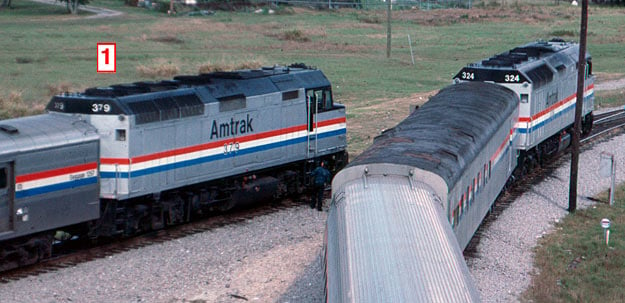
Phase 2b (324, right) and Phase 3 (379, left) F40s meet at Auburndale, FL in January 1989. Collection of Alex Stroshane.
Finally, when stricter EPA regulations took effect in 1980, the Phase 3 version (329-409) was born. The radiator fans were replaced by quieter Q-fans (1), but since there was no low-profile housing available for those, they had to be recessed into the roof to stay within the clearance envelopes. Phase 3 F40s share other spotting features with the Phase 2b F40. Although Amtrak’s F40PH roster was mostly completed in 1980, additional units were ordered as late as 1988 - meaning their last new F40 was delivered twelve years after the first!
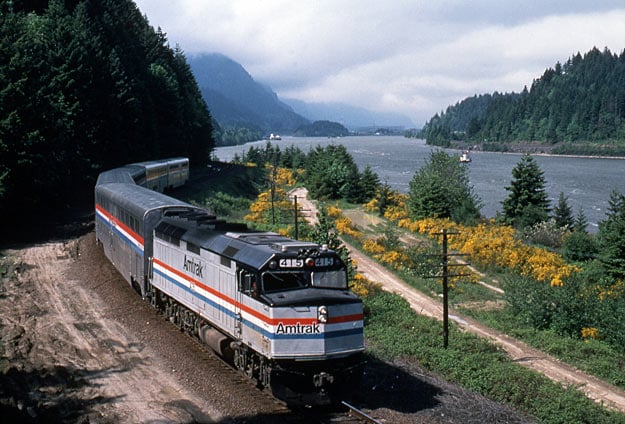
Amtrak 415, an ex-GO Transit unit, showing some of the details unique to those units. Collection of Matt Donnelly.
The final addition to Amtrak’s F40PH fleet came in 1990, when six more were purchased from GO Transit in Toronto. These units resembled Phase 2a in appearance, but sported a few Canadian details such as the ribbed anticlimber (1) and larger Pyle sealed-beam headlight (2). They had also been built without dynamic brakes, but had them retrofitted during a rebuild at Conrail’s Juniata Shops. Their dynamic brake grilles (3) are not as tall as on the rest of Amtrak’s F40s, and the slats in those grilles are spaced closer together.
Most of the additional F40PH units ordered by commuter agencies can be grouped into these three phases, based on when they were built. For example, Chicago RTA (now Metra) acquired F40PHs that are similar to Phase 1 and Phase 3, while Boston’s MBTA received Phase 2 and Phase 3 units.
Era Specific Detail Variations
As Amtrak’s F40PH fleet aged, they were rotated in and out of the shops for repainting and overhauling. Many had new equipment added, such as cab air conditioners and eventually ditch lights. These modifications are the things rivet counters go nuts over, and the F40s sure had their share. We’ll look at some examples of these typical modifications over the life of the units, concentrating on the Phase 1 group.
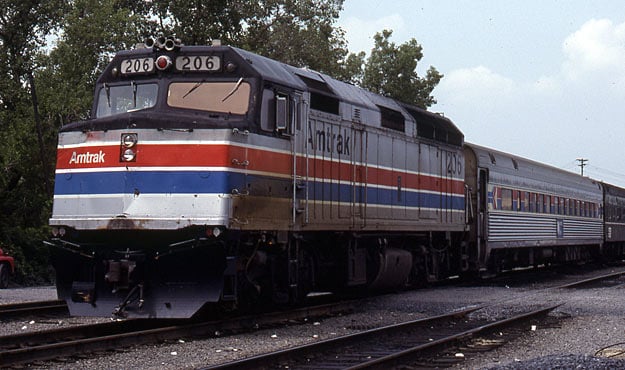
Amtrak 206 at Albany-Rensselaer, NY on July 28, 1979. Photo by Gerrit Bruins, collection of Alex Stroshane.
For the first several years of their lives, the early F40s wore Amtrak’s “cigar band” paint scheme, commonly known as Phase II. (We’ll use Roman numerals to differentiate paint schemes from locomotive phases.) As was common at the time, they had ACI data labels (1) applied on each side.
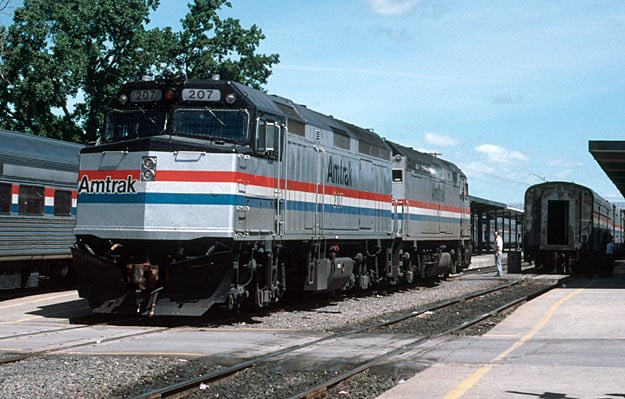
Amtrak 207 and 397 at Albany-Rensselaer, NY on June 14, 1988. Photo by Gerrit Bruins, collection of Alex Stroshane.
By 1979, later F40PH units (starting with 294) were being delivered in the Phase III paint scheme, with equal-width red/white/blue stripes. Some of the Phase 1 units were repainted soon after, but many kept their original paint much later into the 1980s.
The Phase 1 units initially assigned to service on the Northeast Corridor and other New England routes often passed through rough urban areas, and received protective metal grates over the windshields (1). This was to prevent foreign objects from smashing through the glass and injuring the engineers.
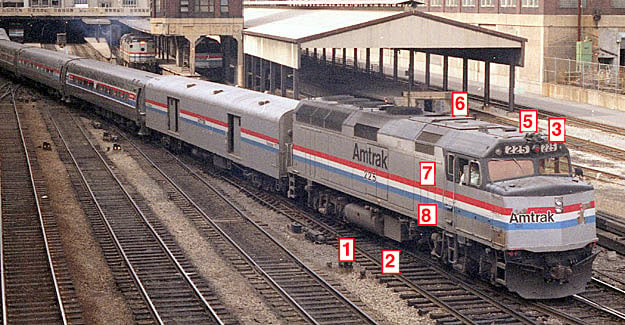
Amtrak F40PH 225 departing Chicago Union Station in June 1985. Photo by Bill Hakkarinen.
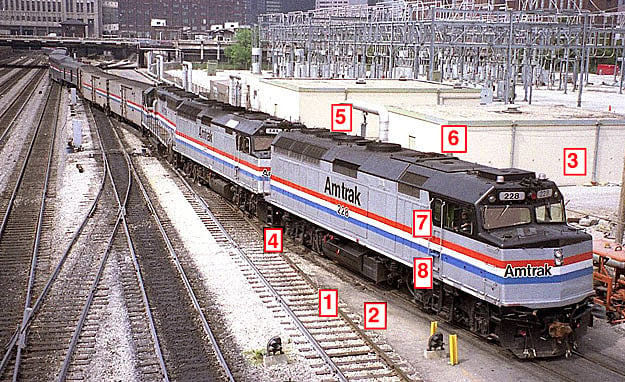
Amtrak F40PH 228 departing Chicago Union Station in June 1992. Note the larger strobes and air conditioner atop of the cab. Photo by Bill Hakkarinen.
In the above two photos, we can compare a typical 1980s F40 with a typical 1990s version. On the Phase 1 units, the fuel tanks (1) were eventually extended forward to match the capacity of the later Phases. The battery boxes (2) were shortened as a result.
In the early ‘90s, the signature white xenon strobes on the roof (3), which flashed a single flash in unison, were upgraded to a slightly larger and brighter strobe light. The newer “Star” strobes were also a single flash design, but flashed independently of each other creating a random flash pattern. A reflective white stripe (4) was added to the side sills.
Many of the F40s also received cab air conditioners (5) in place of the blank plates that they had been built with. Their exhaust stacks (6) were relocated from the rear of the hatch to the front and took on a slightly different shape. On some units, the cab door windows (7) were changed to a sealed version with rounded corners, and the steps (8) were recessed to make them safer
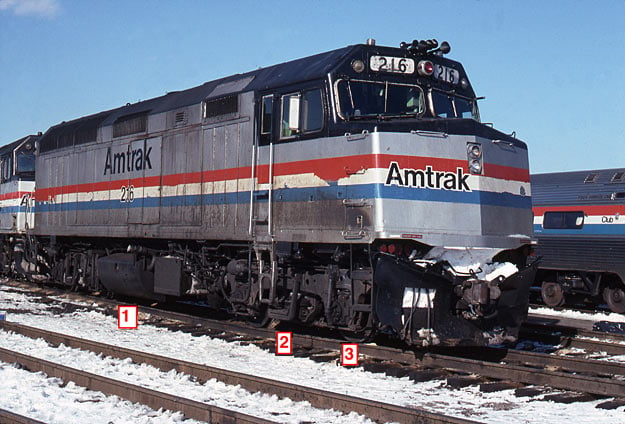
Amtrak 216 is seen looking a little worse for wear on February 14, 1990. Collection of Matt Donnelly.
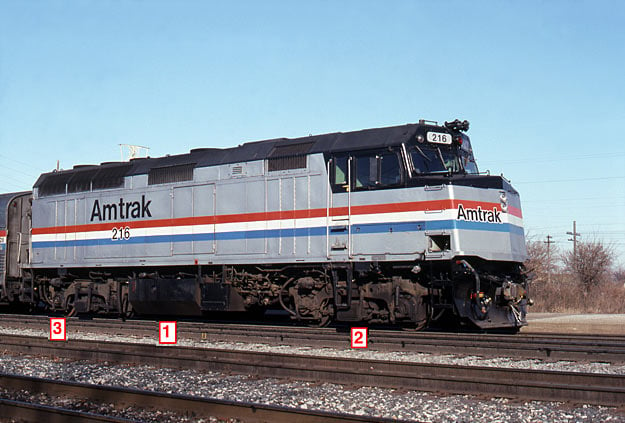
After spending some time in the shop, the 216 displays some interesting detail variations on December 27, 1992, including Amtrak lettering and road number much further back than usual. Collection of Matt Donnelly.
Here are some more comparison photos showing the 216 at different points in time. In addition to the replacement fuel tank (1), likely due to a derailment, the original Blomberg M trucks have been swapped for the “inclined bolster” version (2) that came standard on Phase 3 F40s. The difference is in the appearance of the spring pad at the bottom center of the truck. Also, even on units that kept their original trucks, Hyatt journal covers were standard from the factory, but began giving way to exposed roller bearing caps (3) in the 1990s.
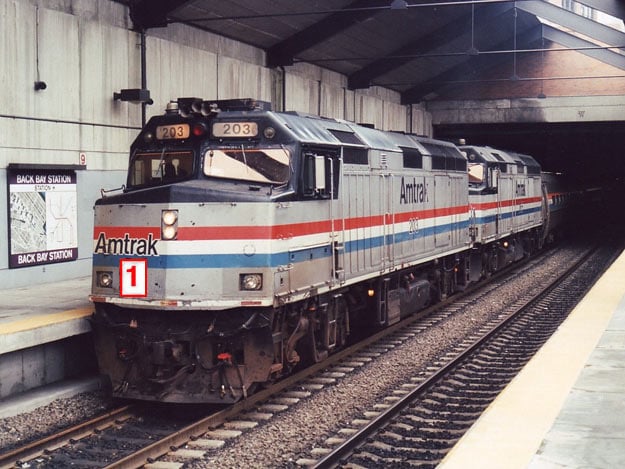
Amtrak 203 is eastbound in Boston, MA on June 23, 1998. Photo by Bill Hakkarinen.
The final change made to the Phase 1 F40s was the addition of ditch lights (1) in the mid-1990s. Not all received this modification, because they were nearing the end of their service lives and began to be retired around 1998 as new P42DCs were being delivered. Some, like the 203 seen above, soldiered on until as late as 2001 or 2002. Unfortunately, none of the Phase 1 group have survived intact. Those that were sold have been scrapped, and those kept by Amtrak were converted into Non-Powered Control Units (NPCUs)for use on push-pull trains.
The Final Chapter: NPCUs
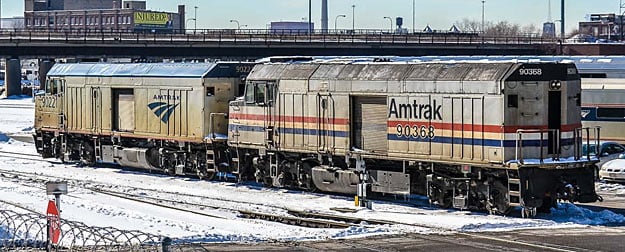
Phase 1 NPCU #90221 in Phase V paint sits with Phase 3 NPCU #90368 in Phase III paint in Chicago during February 2014. Note the large roll up door in the center of the units. Photo by Matt Donnelly
Starting around 1997, Amtrak began rebuilding some of their retired F40s into NPCUs. The first was F40 368, renumbered 90368 once converted. Thereafter, a number of Phase 1 F40s were converted, including F40 #200 (the first unit produced).. The prime movers, traction motors and other internals were removed, leaving behind an empty carbody with functional controls in the cab. With the addition of a large roll-up door on each side allowing access to the empty engine room for use as a baggage compartment, these units could now be used as cab control units for push-pull service, while also doubling as baggage cars. This earned them the nickname “cabbages.”
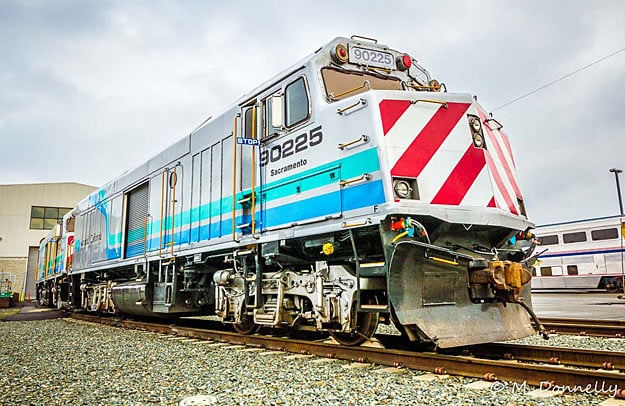
Phase I NPCU #90225 (Former F40PH #225) was painted into retro CalTrain colors for Amtrak California service in 2014. Photo by Matt Donnelly
As more F40s were retired, additional NPCUs were built, including some that were dedicated for use in relatively captive corridor services. Some are based out of Chicago to operate on various hub services (mainly the Hiawathas today), the Cascades service in the Pacific Northwest (featuring a service specific livery), the Downeaster in northern New England (with service specific markings), as well as the Heartland Flyer for most of the first decade of the 2000s. One NPCU is assigned to Los Angeles for the single level Surfliner set, and occasionally a Cascades service NPCU has migrated south and run on this train. Three NPCUs have been painted into retro CalTrain colors for Amtrak California service based out of Oakland..In addion to the service specific schemes, NPCUs have worn Phase III, Phase IV and Phase V standard Amtrak paint schemes. Although their days of pulling Amtrak trains are over, it’s fascinating to think that several of the original F40s can still be seen in daily service as NPCUs, even as they pass 40 years of age.


